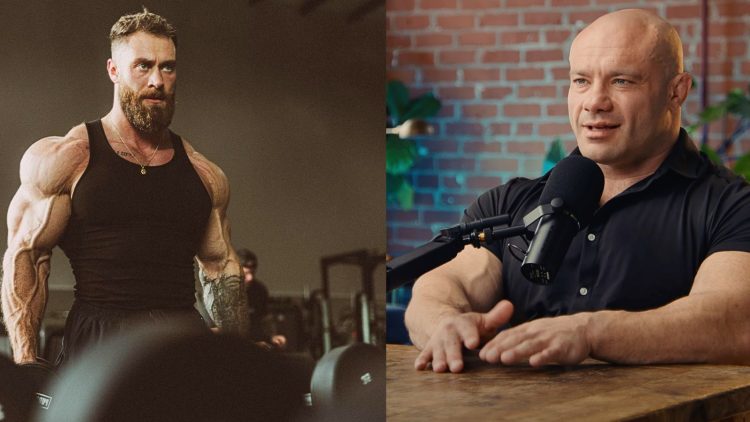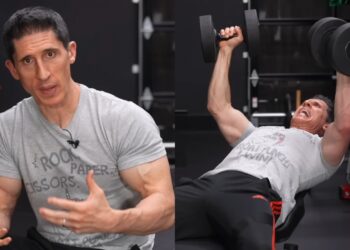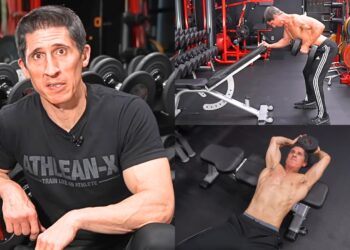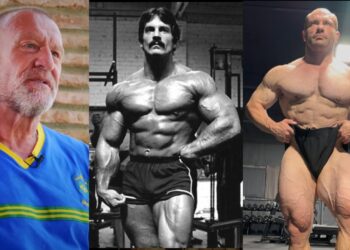Dr. Mike Israetel, an established exercise scientist, has curated thousands of studies on hypertrophy and continues to offer fans valuable and actionable guidance. In his latest offering, Dr. Mike Israetel discussed how to maximize muscle growth, elaborating on controlling the concentric, deep stretches, and executing proper technique.
Let’s face it, when it comes to muscle growth, lifters aim to seek any advantages possible in their quest for a more ripped physique. While the fitness community is oversaturated with information on achieving such goals, Dr. Mike Israetel presents his knowledge of hypertrophy succinctly to offer his following simple steps for building a muscular body.
Israetel holds a Ph.D. in sports physiology and imparts wisdom to fans courtesy of his thriving YouTube channel Renaissance Periodization, which boasts over 1.3 million subscribers. Having collaborated with other exercise masterminds such as Brad Schoenfeld and Jeff Nippard, he brings color to the fitness sector with unique and memorable explanations.
If the objective is to elevate your physique to a new level, Israetel’s guide on building muscle will help you get there. Below, he provides a framework and guide for hypertrophy, emphasizing his best methods that can be applied to any workout.
Level Up Your Fitness: Join our 💪 strong community in Fitness Volt Newsletter. Get daily inspiration, expert-backed workouts, nutrition tips, the latest in strength sports, and the support you need to reach your goals. Subscribe for free!
Exercise Scientist Explains How To Get Jacked and Build More Muscle During Workouts
In most exercises, the eccentric portion of the rep involves lowering the weight like when someone descends for a squat. Israetel believes controlling the eccentric is critical for anyone aiming to build more muscle.
“Control in general, especially on the eccentric. Most people can’t help but control the concentric because it pushes back. You can only move a concentric so quickly, especially with heavier weights, especially close to failure. So, someone can’t really spastically do the concentric pushing against it is kind of auto-controlled.”
Israetel explains how to reap benefits from the eccentric portion of a lift, and reveals that many lifters miss out on muscle growth because they let the weight drop versus controlling the downward shift.
“If you’re trying to gun your car up a really high hill and you have anything other than a Tesla, it’s going to be seemingly like you’re controlling it but it’s just pushing back that’s auto control.
On the eccentric however on the way down, people a lot of times are like – they just let it drop which again, isn’t terrible, it does marginally increase your chance of injury but what it does is it takes a very muscle growth promoting part of the movement which is the eccentric and the eccentric actually requires less nervous system stimulus to do the same amount of physical work, which means its inherent stimulus-to-fatigue ratio might be higher.”
He stresses that lifters who quickly lower the weight instead of controlling it are leaving gains on the table.
“It has to come down and you might as well collect all the coins on the way down, there’s free hypertrophy coins, just do it,” adds Mike Israetel.
Although bodybuilding legends such as Arnold Schwarzenegger acknowledge the value of partial reps, Israetel maintains that a full range of motion is optimal for growing muscle.
“I used to say full range of motion. I still think that’s mostly correct. But, we’re learning there are different parts of the range of motion which are more or less that are hypertrophic so I can say is mostly full range of motion is good technique so if I see you quarter squatting, I’ll be like, if you probably went lower it’s a good thing but more importantly, still, from an empirical perspective, is just not robbing yourself of the deep stretch.”
“We have very good control trials where the only difference between groups or applications is one group goes nice and deep and the other does not. We have studies on for example, the quadriceps where the volume and the load is identical between groups you even got clever studies where people train one leg with a deep stretch only bottom third, and the other leg they train only with the top third of leg extension. That’s a big deal because of auto-control. It’s not like genetics doesn’t matter, nothing matters.”
In addition, the exercise scientist underlines the importance of a deep stretch during each rep, clarifying that this practice can result in 5-10% more muscle growth.
“A lot of the studies are showing that just the deep stretch causes more growth. Now, it’s 5-10% more growth. So, you can do top end partials.
You can bench like this and get plenty of muscle growth, tons of IFBB Pros and jacked-up juice heads do it and are still jacked. But from an efficiency and effectiveness perspective, all those guys could have been bigger if they went in for that really deep stretch.”
Proper form and repetition consistency are vital for hypertrophy, according to Israetel.
“That’s a big part of really good technique,” adds Israetel. “Unstable exercise is much more injurious than stable exercise”
“Repetition consistency, most of your reps should look about the same. That doesn’t mean identical. There’s actually a little bit of an injury-preventative benefit from exposing yourself to slightly different bar positions. It makes you more resilient.”
Isometric exercises have their place in routines. However, without a stretch and a powerful contraction, Israetel contends that they are less effective than executing reps with a full range of motion.
“Isometrics just don’t seem to be as hypertrophic. Isometrics in a stretch position are plenty hypertrophic and in a contracted one they are not. For example, if you’re doing cable flyes, if you stop at the squeeze, people will give that cue, it’s totally cool for variation, it’s fun, it’s awesome, it grows muscle, but I wouldn’t say it’s essential and it might be a downside. All that energy you’re spending stopping at the squeeze you could put into the eccentric which probably grows more muscle.”
Discovering how to maximize hypertrophy is among Dr. Mike Israetel’s top priorities as a leading name in fitness. He recently listed the 10 exercises he would pick to achieve muscle growth but cautioned his audience that what works for him, might not suit your training style best.
Having delved into studies and research so you don’t have to, Dr. Mike Israetel is committed to offering his fans easy-to-understand knowledge on achieving a more impressive physique through proper hypertrophy-inducing exercise.
RELATED: Exercise Scientist Reveals Strategy for Developing Unstoppable Gym Motivation









